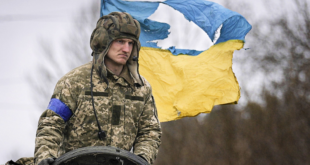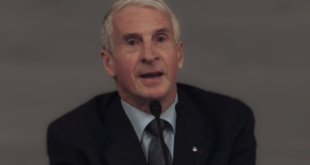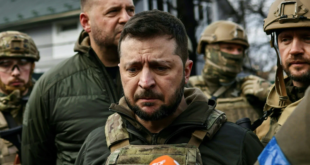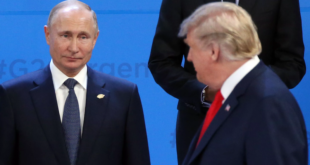The Kremlin Will Eventually Tire of Its Reliance on China
As Russian President Vladimir Putin’s war on Ukraine drags on and realigns global geopolitics, the United States needs to review and revise its long-term strategy toward Russia. The primary focus of this strategy, not unlike the original Cold War–era strategy of containment articulated by George Kennan in this magazine 75 years ago, must once again be a “patient but firm and vigilant containment of Russian expansive tendencies.”
During the Cold War, the United States sought to check the expansionist impulses of the Soviet Union without engaging in direct military confrontation, waiting until the unnatural Soviet regime in Moscow collapsed. Today, the objective of containing Russia is different, since it would be naive to expect Russia to disintegrate as the Soviet Union did. As Kennan himself recognized, “The Soviet Union will not last, but Russia will.”
Instead, the United States must work diligently to hold back Russia’s expansionism in Europe and elsewhere until the Russian leadership—either the current one or some future iteration—realizes that its destructive imperial tendencies are leading it to the bleak future of becoming a vassal of China. Increasingly cut off from the West, Moscow will become beholden to Beijing as a trade partner and key international patron, a relationship not between equals but between a supplicant and a benefactor. Such a reckoning with its dependence on China might cause the Kremlin to rethink its pursuit of malign anti-Western policies and restrain its aggressiveness.
The United States should be under no illusion that such a transformation will result in a friendly relationship with Russia, much less an anti-Chinese alliance, or that a change in Russia’s behavior will occur quickly. Indeed, it may be years before Russian leaders adopt a less confrontational posture toward the West. It is quite unlikely that Russia will ever become integrated in the Western community. Nor is it likely that Russia will ever sacrifice its relationship with China for warmer ties with the United States and Europe. The United States will have to accept substantial differences between the basic values and long-term interests of Russia and those of the West, such as support for human rights and democratic governance.
Nevertheless, the Kremlin could eventually conclude that a policy of even-handedness—maintaining productive ties with both China and the West—is in its best interest. Another Russia is possible, one with a more balanced foreign policy that avoids close entanglements with either China or the West, that respects the territorial integrity of other states, and that adheres to its international legal obligations. The United States must be patient and willing to wait for Russia to realize that it has little to gain from a future of subservient dependence on China.
STALEMATE AND VASSALAGE
Six months after Russia invaded Ukraine, the war’s future course remains uncertain. While Putin has fallen far short of achieving regime change in Kyiv, Russia has managed to grab about a fifth of Ukraine. The Ukrainian army has outperformed all expectations, but it may not be in a position to quickly and fully roll back Russia’s gains, and a near-term stalemate looks increasingly likely.
Russia’s control of eastern Ukraine can never be fully secure. Consider, for instance, that it took the Soviet Union more than a decade to suppress the Ukrainian insurgency after reestablishing its control over Ukraine at the end of World War II. Nor will the territories occupied by Russia fully recover from the economic ruin wrought by the war. Moscow does not have the money to revive the devastated areas it has conquered, but it will probably try to do so anyway, expending scarce resources.
Russia will realize that it has little to gain from a future of subservience to China.
Faced with a stronger NATO, which will soon add Sweden and Finland as members, Russia will be forced to spend ever more on its military, draining its coffers and forcing it to divest from social services, infrastructure, science, and education. Putin’s land-grabbing imperialistic misadventures will leave Russia a poorer, sadder, more repressive, more insecure, and ultimately less attractive place to live. Even if Putin claws his way to something he can call a short-term victory in Ukraine, he has already lost Russia in the long term. If the Western sanctions remain, the Russian economy will stagnate and wither, increasing its reliance on Beijing, a prospect that few in Moscow relish.
Russia has already begun diverting energy and mineral exports from hostile European markets to China. Russian consumers will increasingly rely on Chinese imports to replace Western products that are no longer accessible. The yuan, the Chinese currency, is now playing a major role in transactions on the Moscow Stock Exchange, a role that will only get bigger. In effect, the stability of the Russian economy will rest on injections of Chinese cash and goods, a dynamic that will allow Beijing a great deal of leverage over Moscow.
In these circumstances, the United States should continue building up the Ukrainian military’s capabilities while maintaining and strengthening sanctions on Russia, including export controls on important technologies that Russia needs and is struggling to access, such as semiconductors. These measures would help sustain the Ukrainian war effort while weakening Russia, but they do not make up a long-term strategy. To pave the way for a future nonaligned Russia, the United States must avoid escalation in Ukraine, stave off Russia’s complete destabilization, and provide Moscow with an alternative to its dangerous overreliance on Beijing.
THE LONG GAME
As the war in Ukraine grinds on, the top priority for the United States and its NATO allies has been—and will remain—preventing any sort of escalation that would result in a direct conflict between NATO and Russia. NATO has repeatedly and wisely signaled to Russia its desire to avoid a clash over Ukraine, and the United States is exercising patience and forbearance. This desire is why NATO has resisted Kyiv’s pleas to enforce a no-fly zone over Ukraine, which would risk engaging NATO fighter pilots in aerial combat with Russian forces.
Yet both Russia and NATO are continually testing each other’s redlines. The West has grown progressively bolder and more involved in the conflict, supplying critical intelligence that the Ukrainians have used to attack Russian ships and other strategic targets. NATO allies have also given Ukraine advanced weaponry, such as High Mobility Artillery Rocket Systems, which the Ukrainian military is using to inflict serious damage on Russian ammunition depots and bases far behind the frontlines. So far, the allies have correctly assessed that Putin, having lost an estimated 20 to 30 percent of his combat force, is in no military position to escalate the conflict, and that as long as Putin can avoid losing face publicly, he is unlikely to respond aggressively to Western supplies of weapons and intelligence to Ukraine.
But a direct engagement by NATO forces in the skies, on the ground, or in the Black Sea near Ukraine would be a different story. Such activities could prompt a trigger-happy Russian battlefield commander to take an action that results in the death or injury of NATO personnel. This outcome would provoke a response from NATO, potentially setting off a cycle of escalation that, in the worst-case scenario, could culminate in a nuclear conflict. Such a scenario must be avoided at all costs.
Another outcome that the United States should want to avoid is the outright implosion of Russia. The United States should continue to punish Putin for the war in Ukraine, but it must not lose sight of the fact that destabilizing Russia—or even breaking Russia apart, as some commentators have called for—is not in its interest. During the tail end of the Cold War, President George H. W. Bush worried about the Soviet collapse, not because the Soviet Union was worth preserving, but because the breakup of a major nuclear power risked unleashing loose nuclear weapons and fissile material, spurring nuclear proliferation among successor states, and prompting the emergence of new terrorist and organized crime networks. Four decades later, these risks remain. Russia’s collapse could lead to a bloody civil conflict that might destabilize Eurasia for years to come.
The likelihood of a popular uprising in Russia remains low, as Putin’s hold on power, buoyed by a well-funded apparatus of domestic repression, seems as secure as ever. Although they have diminished Russian economic power, the sanctions levied thus far on Russia have not caused anything like the devastation and humiliation that Russians endured in the 1990s during the economic crisis triggered by the Soviet Union’s collapse.
But experience suggests that the current appearance of calm may be misleading. U.S officials may not know the full extent of the backstabbing that could be occurring in Putin’s inner circle, nor can they predict what sort of chaos might ensue once the all-powerful autocrat begins to lose his grip. Putin’s eventual exit, voluntary or otherwise, will likely be followed by a bitter power struggle, much like the one that followed the death of Stalin in 1953. No matter who takes his place, Putin’s nationalistic and revanchist policies will probably endure once he is gone, just as Nikita Khrushchev continued and even intensified Stalin’s confrontational anti-Western policies, ultimately leading to the Cuban missile crisis in 1962.
The United States should tread lightly, recognizing that economic meltdown and political chaos are poor backdrops for building liberal polities. It should not regard the emergence of a liberal democratic state in a post-Putin Russia as a historical inevitability. The past weighs heavily on Russia, not only in the sense that Russia’s repressive institutions harbor remarkable staying power, but also because of the persistent conformism and political indifference of the Russian people, on whom the United States once naively pinned great hopes for Russia’s democratic transformation. The United States cannot allow the expectation of eventual democratization in Russia to form the basis of its long-term policy. Realizing a true Russian democracy is a job for the Russian people themselves, and Washington’s ability to influence such an outcome has always been and will remain extremely limited.
A NONALIGNED RUSSIA
The last 30 years have witnessed Russia’s failure to anchor itself in the West. Unlike Germany and Japan, which landed on stable perches in the Western order after being vanquished during World War II, Russia has refused to come to terms with its diminished post-Soviet stature. The United States tried to cater to Moscow’s craving for respect by inviting Russia to join the G-7 club of developed nations (it has since been kicked out) and by establishing a joint NATO–Russia Council. Yet Russia continues to nurse its various grievances, succumbing to toxic nationalism and imperialism.
U.S. policymakers should nevertheless continue to explore ways to expedite the emergence of a less belligerent Russia, if for no other reason than to reduce tensions between the two largest nuclear states while making it more difficult for China to benefit from Russia’s weakness.
Moscow and Washington share an interest in creating a Russia that is not a Chinese vassal.
The United States should encourage Russians to at least imagine a future in which Russia is an influential, independent player on the global stage that seeks to peacefully and profitably coexist with the West. Russia and the West share an interest in creating a Russia that is not a Chinese vassal or supplicant, and Russia’s potential neutrality—its nonalignment in the current strategic competition with China—is perhaps the biggest carrot the United States can offer. U.S. messaging to Russia should reinforce what the Russian policy elites already know to be true: that China is merely looking after its own interests and that it sees Russia only as an instrument to achieve them.
The West will likely be helped in this task by China itself. Indeed, Beijing has already begun driving a hard bargain with Moscow, for instance by taking advantage of Russia’s desperate need to sell energy to negotiate substantial discounts. In the past, China has tolerated Russia’s independent relations with India and Vietnam and grudgingly respected the Kremlin’s significant role in Central Asia. But as China comes to understand its enormous leverage over Russia, it will seek to shape Russian foreign policy in ways that serve its own interests.
Such heavy-handed Chinese policy will give the Russian political establishment ample reason to rethink its inveterate hostility toward the West. Moscow will eventually recognize that it can extend its international influence and increase its leverage with other powers (including China) by restraining its aggressive impulses in Europe.
Ironically, Russia could have secured a future in which it peacefully coexisted with the West if not for Putin’s most recent imperial designs. Instead, his aggression in Ukraine has made Russia’s—and the United States’—task much more difficult. But there is still an opportunity for correcting Putin’s senseless and criminal mistakes, even if Russia must first be punished. Russia must decide whether it wants to continue to live in angry isolation, but Washington can remind Moscow that other options are available if Russia shows a genuine interest in correcting its destructive and self-destructive proclivities. Until that day comes, the United States must contain the worst of Russian behavior and wait for the tide to turn.
 Eurasia Press & News
Eurasia Press & News




